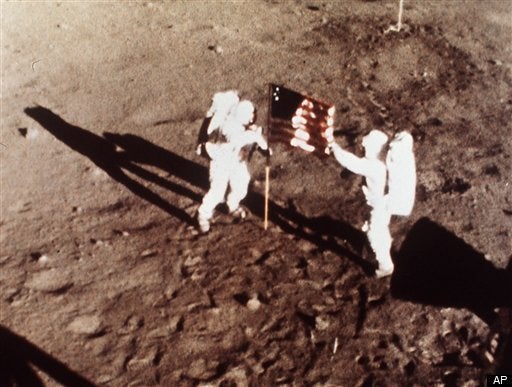
Forty years ago this week, the Astronauts of Apollo 11 became the
first humans to set foot on the Moon, ushering in a new era of human
exploration of the universe. Indeed, even by today's standards, the
Apollo program was nothing short of astounding. With an average age in
the late 20s, Apollo engineers were forced to substitute creativity
and youthful ambition for experience as they worked to develop the
technology to send humans to the Moon and to bring them back. Given
the freedom to design without preconceived notions, these young
innovators were able to achieve the seemingly unachievable, all in a
staggering eight-year period.
Since then, the world's space agencies have made steady and important
progress in their exploration of space with rovers, space telescopes,
shuttles, and space stations. Yet, even after forty years, our
ambitions to send explorers back to the Moon and, eventually, deeper
into space have not yet become a reality. As we reflect on the
accomplishments of Apollo, we honor the program's giant leaps, and
recognize that our efforts to explore the universe have only just
begun.
We believe the time is ripe for private industry to assist in creating
a new era of sustainable, international lunar exploration -- a "Moon
2.0." If the first version of mankind's journey to the Moon was about
flags and footprints, Moon 2.0 is focused on a new standard of
sustained participatory exploration and the expansion of new markets
and economic opportunities. But in order for Moon 2.0 to match and
even exceed the triumphs of the first era of lunar exploration, we
will need to find a way to liberate the genius of human beings all
around the planet to meet the rigorous demands of a sustainable
exploration program.
The Google Lunar X PRIZE is our solution to that problem. Announced in
late 2007, the Google Lunar X PRIZE is designed to jump-start Moon 2.0
by providing an undeniable incentive for a new generation of engineers
and spacecraft. This $30 million dollar competition -- a new race to
space -- has already inspired 19 teams representing more than 40
countries to try to become the first private organization to land a
rover on the Moon, move safely around the lunar surface, and return
high definition video and photographs to eager audiences here on
Earth. Indeed, it is our hope that the world will be riveted by the
competitive spirit of the contenders and by the data that they will
transmit back to Earth. Through this competition, we look forward to
sparking a renewed interest in space and inspiring a new generation to
make discoveries that will have benefits all around the world.
And this week, moving Moon 2.0 into 3D, Google has just released the
Moon in Google Earth, which provides a free and intuitive platform for
people of all ages to explore photographs and data collected from 40
years of lunar missions, including the Apollo missions.
We believe that providing such a simple method for users to virtually
"surf" around the surface of the Moon will help recreate some of the
sense of wonder that so many felt as they gathered around their
televisions to watch the Apollo astronauts explore the lunar surface.
People all around the globe, regardless of age, gender, or educational
background, will be able to explore the stunning and intriguing data
returned from government spacecraft and, eventually, the Google Lunar
X PRIZE winning teams.
Both the prize and the software are being offered at a unique moment
in time. The Moon has once again caught the attention of the world --
not only is it a focus of civil space agencies, it is a focal point
for the burgeoning commercial space industry as well. We expect that
the technological and financial successes achieved by many of the
private teams competing for Google Lunar X PRIZE will help lower the
cost of lunar exploration by an order of magnitude or more. A
commercial mechanism will emerge that allows us to accomplish more for
less money, presenting space agencies around the world with new
customers and new opportunities.
This progress will lead to enormous benefits not only for space
exploration, but for quality of life here on Earth. Along the way,
both the Google Lunar X PRIZE and the Moon in Google Earth will serve
as sources of information and inspiration for all people as we watch
compelling content developed as a result of these initiatives. Moon
2.0 and Moon in Google Earth will enable a new generation to fall in
love with space, and will help them to better understand both the
capabilities of advanced technology and the benefits of lunar
exploration.
Larry Page is co-founder of Google, Inc. and Dr. Peter H. Diamandis is Chairman and CEO of X PRIZE Foundation.